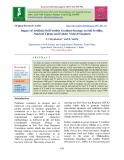
Green fodder
-
To study the impact of artificial creation of soil fertility gradient strategy on soil fertility, nutrient uptake and green fodder yield of sorghum (var. CO 30) by following inductive methodology (fertility gradient concept), a field experiment was conducted during 2014-15 at farmer’s holding of Coimbatore district. The experimental field was divided into three equal strips and three graded levels of fertiliser N, P2O5 and K2O were applied in the form of urea, single super phosphate and muriate of potash, respectively to strip I (N0P0K0), II (N1P1K1) and III (N2P2K2).
 7p
7p  chauchaungayxua6
chauchaungayxua6
 26-06-2020
26-06-2020
 20
20
 4
4
 Download
Download
CHỦ ĐỀ BẠN MUỐN TÌM














